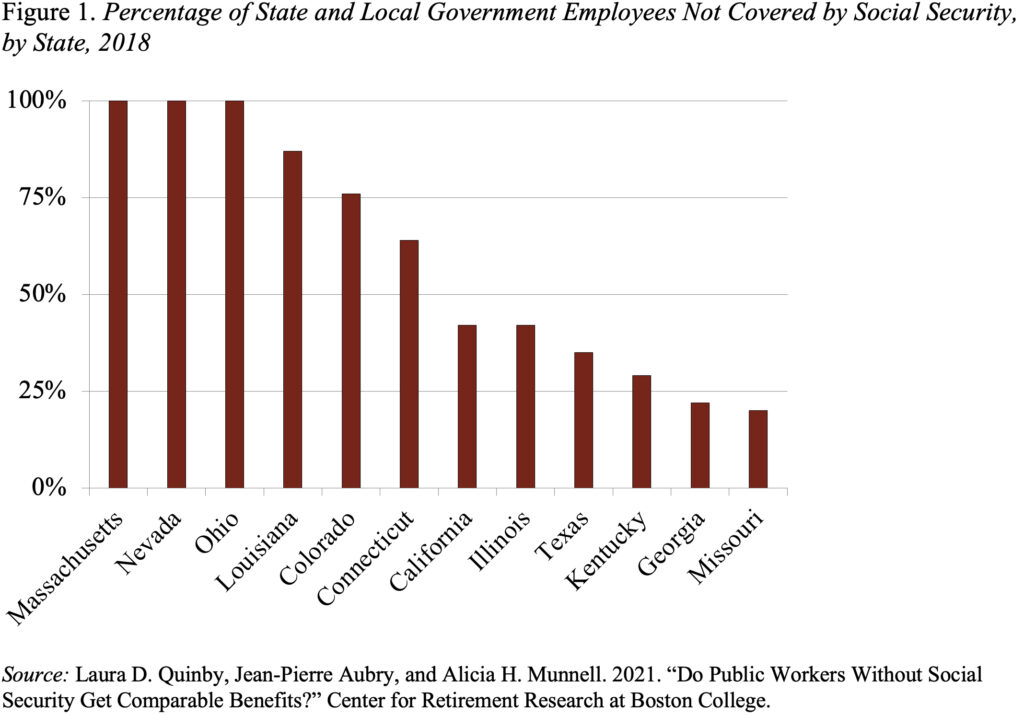Trying to the underlying drawback — uncovered state and native staff.
Each analyst who is aware of something about Social Safety agrees that the Social Safety Equity Act, signed by President Biden on January 5, is a horrible piece of laws. It merely offers away cash to some state and native staff – those that will now profit unfairly from the progressivity of the system’s profit system and from advantages designed for non-working spouses. Eliminating the Windfall Elimination Provision (WEP) and Authorities Pension Offset (GPO) makes Social Safety much less – no more – truthful. For specifics of the windfalls, see my latest weblog publish or the most detailed instance ever from my good friend Andrew Biggs.
Sure, the case for the WEP and GPO includes some understanding of Social Safety. Sure, the availability may have been higher designed. Sure, it infuriated state and native workers. However these changes had been designed to repair an actual fairness problem. How may any well-informed member of Congress vote to eradicate them – losing cash, accelerating the exhaustion of the belief fund, and making the 75-year financing gap greater?
Personally, I settle for my share of the failure of consultants to make a compelling case to the general public and to the employees and members of Congress for the wanted changes. However I feel it’s time to simply accept defeat and transfer on. Essentially the most constructive factor to do at this level is to repair the supply of the issue – that’s, lengthen Social Safety protection to the 25-30 p.c of state and native staff who aren’t lined by Social Safety.
A bit of background. The Social Safety Act of 1935 excluded state and native staff from obligatory protection as a consequence of constitutional considerations about whether or not the federal authorities may impose taxes on state governments. As Congress expanded protection to new teams of personal sector staff, it additionally handed laws within the Fifties that allowed states to elect voluntary protection for his or her workers. Whereas many states did be a part of, our calculations present that 26 p.c of the state and native workforce in 2022 – 5 million staff – nonetheless aren’t lined by Social Safety. The majority of uncovered staff (77 p.c) reside in seven states – California, Colorado, Illinois, Louisiana, Massachusetts, Ohio, and Texas. In California, Illinois, and Texas, uncovered state and native staff represent 42 p.c, 42 p.c, and 35 p.c of the entire, respectively (see Determine 1). In Massachusetts, Ohio, and Nevada, no authorities staff are lined by Social Safety.

If all state and native staff had been lined, the necessity for fairness changes, such because the WEP and GPO, disappears. Furthermore, increasing protection would make sure that all staff are paying their share of the legacy prices related to the startup of Social Safety and are contributing to the redistributive parts in this system. On the similar time, extending protection would additionally enhance the retirement earnings of many state and native staff, who’re reliant on public pension plans much less beneficiant than Social Safety, and supply them with vital ancillary protections that they at present lack, resembling spousal and survivor advantages. Social Safety additionally presents complete incapacity insurance coverage.
In fact, a proposal to increase protection sparks the predicable outcry from public worker unions and state/native governments relating to the prices. Just about all proposals for mandating Social Safety protection are restricted to new workers solely, which might ease the transition. And the magnitude of the last word price relies upon crucially on how plan sponsors reply to the introduction of Social Safety – that’s, states and localities are unlikely to easily add Social Safety on high of current provisions. We want some cautious estimates of the vary of potential outcomes.
Then again, extending protection to the 5 million uncovered staff would contribute to closing Social Safety’s 75-year deficit. The actuaries’ most up-to-date estimate is that extending protection would scale back the 75-year deficit from 3.50 p.c of taxable payrolls to three.35 p.c.
Let’s overlook in regards to the WEP and GPO band-aids and repair the underlying drawback. It is unnecessary to have a nationwide social insurance coverage system with redistributive options that permits 5 million staff to not take part. That’s a simple argument. Let’s begin crunching the numbers in order that extending protection is without doubt one of the proposals on the desk when the time comes for Congress to design a bundle to unravel Social Safety’s monetary shortfall.

